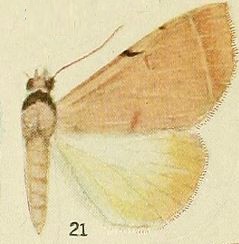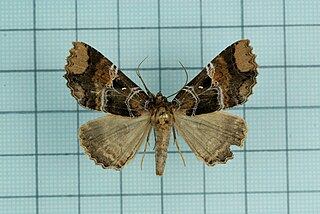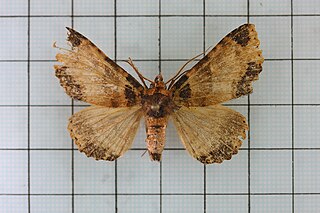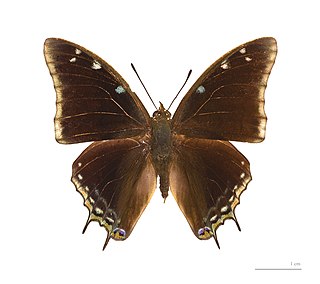
The Calpinae are a subfamily of moths in the family Erebidae described by Jean Baptiste Boisduval in 1840. This subfamily includes many species of moths that have a pointed and barbed proboscis adapted to piercing the skins of fruit to feed on juice, and in the case of the several Calyptra species of vampire moths, to piercing the skins of mammals to feed on blood. The subfamily contains some large moths with wingspans longer than 5 cm (2 in).

The Port of Livorno is one of the largest Italian seaports and one of the largest seaports in the Mediterranean Sea, with an annual traffic capacity of around 30 million tonnes of cargo and 700,000 TEU's.

Ctenusa is a genus of moths of the family Noctuidae.

Serrodes is a genus of moths in the family Erebidae first described by Achille Guenée in 1852.

Sypnoides is a genus of moths in the family Erebidae.

Acidaliastis is a genus of moths in the family Geometridae erected by George Hampson in 1896.
Erastria is a genus of moths in the family Geometridae, found primarily in tropical and subtropical climates in Africa and Asia. The genus was erected by Jacob Hübner in 1813.

Opisthoxia is a genus of moths in the family Geometridae.

Ctenusa curvilinea is a moth of the family Noctuidae. The species can be found from Ethiopia and Eritrea south to South Africa.

Sypnoides chinensis is a species of moth of the family Noctuidae first described by Emilio Berio in 1958. It is found in Taiwan.

Sypnoides pannosa is a species of moth in the family Erebidae that was first described by Frederic Moore in 1882. It is found in India, the Himalayas, Borneo, Sumatra, Thailand and Taiwan.

Charaxes kheili is a butterfly in the family Nymphalidae. It is found in Cameroon, Gabon, the Central African Republic and the north-western part of the Democratic Republic of the Congo. The habitat consists of woodland savanna.

Spilosoma curvilinea is a species of moth of the family Erebidae. It was described by Francis Walker in 1855. It is found in Cameroon, Republic of the Congo, Democratic Republic of the Congo, Ghana, Ivory Coast, Kenya, Nigeria, Senegal, Sierra Leone, Sudan, Tanzania, the Gambia and Uganda.

The Sypnini are a tribe of moths in the family Erebidae.
Acantholipes curvilinea is a species of moth in the family Erebidae. It is found in western China.
Serrodes caesia is a moth of the family Erebidae first described by Warren in 1915. It is found in Indonesia, New Guinea and Thailand. The habitat consists of alluvial forests, dipterocarp forests and primary forests.
Mispila curvilinea is a species of beetle in the family Cerambycidae. It was described by Francis Polkinghorne Pascoe in 1869. It is known from Laos, Cambodia, India, and China.
Glenea curvilinea is a species of beetle in the family Cerambycidae. It was described by Per Olof Christopher Aurivillius in 1926.

Perizoma curvilinea is a species of geometrid moth in the family Geometridae. It is found in North America.

Automeris curvilinea is a species from the genus Automeris. The species was originally described in 1906 by William Schaus.












